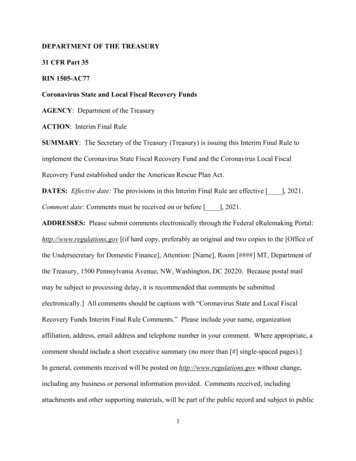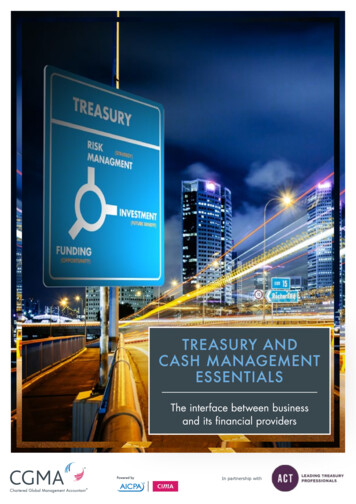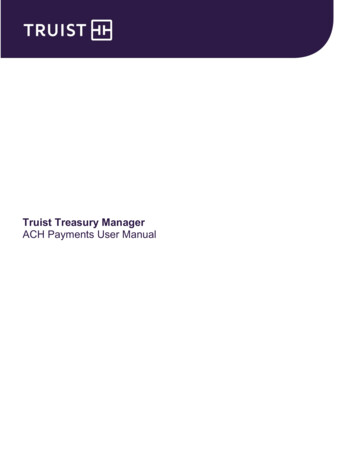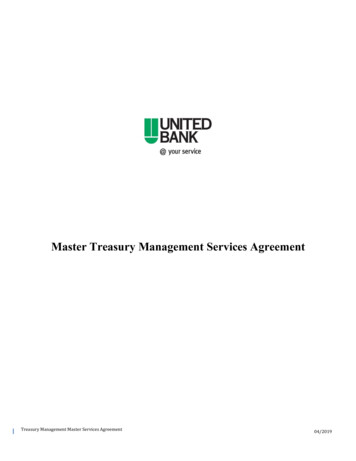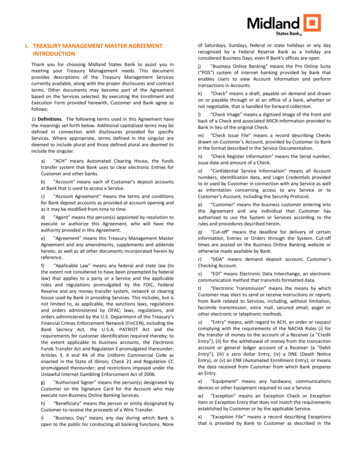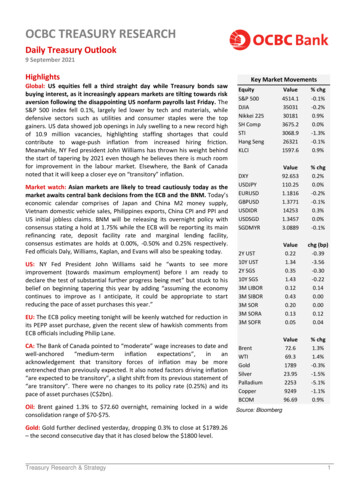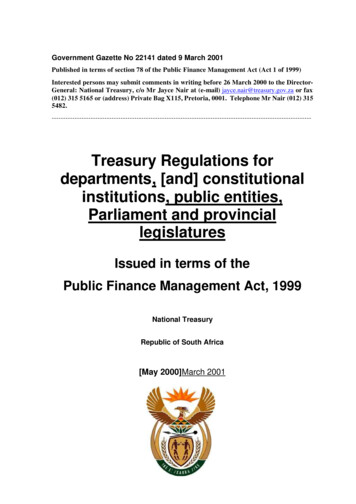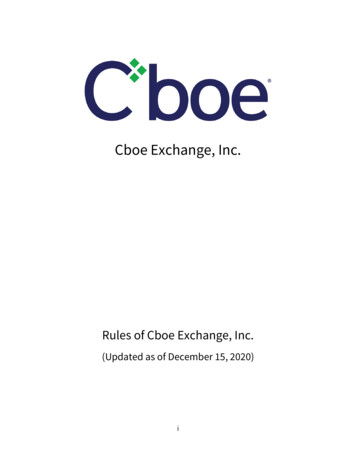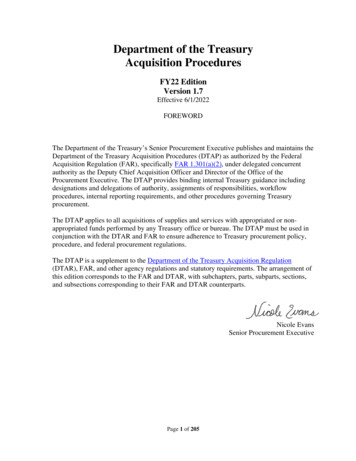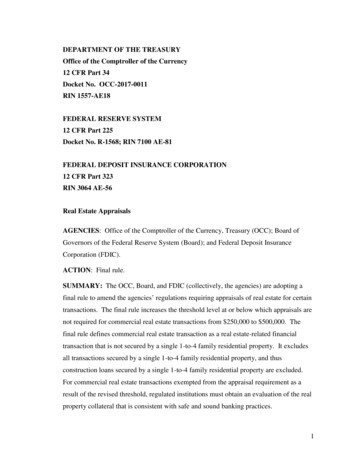
Transcription
DEPARTMENT OF THE TREASURYOffice of the Comptroller of the Currency12 CFR Part 34Docket No. OCC-2017-0011RIN 1557-AE18FEDERAL RESERVE SYSTEM12 CFR Part 225Docket No. R-1568; RIN 7100 AE-81FEDERAL DEPOSIT INSURANCE CORPORATION12 CFR Part 323RIN 3064 AE-56Real Estate AppraisalsAGENCIES: Office of the Comptroller of the Currency, Treasury (OCC); Board ofGovernors of the Federal Reserve System (Board); and Federal Deposit InsuranceCorporation (FDIC).ACTION: Final rule.SUMMARY: The OCC, Board, and FDIC (collectively, the agencies) are adopting afinal rule to amend the agencies’ regulations requiring appraisals of real estate for certaintransactions. The final rule increases the threshold level at or below which appraisals arenot required for commercial real estate transactions from 250,000 to 500,000. Thefinal rule defines commercial real estate transaction as a real estate-related financialtransaction that is not secured by a single 1-to-4 family residential property. It excludesall transactions secured by a single 1-to-4 family residential property, and thusconstruction loans secured by a single 1-to-4 family residential property are excluded.For commercial real estate transactions exempted from the appraisal requirement as aresult of the revised threshold, regulated institutions must obtain an evaluation of the realproperty collateral that is consistent with safe and sound banking practices.1
DATES: Effective date. This final rule is effective on [INSERT DATE OFPUBLICATION IN THE FEDERAL REGISTER].FOR FURTHER INFORMATION CONTACT:OCC: G. Kevin Lawton, Appraiser (Real Estate Specialist), (202) 649-7152, Mitchell E.Plave, Special Counsel, Legislative and Regulatory Activities Division, (202) 649-5490,or Joanne Phillips, Attorney, Bank Activities and Structure Division, (202) 649-5500,Office of the Comptroller of the Currency, 400 7th Street, SW, Washington, DC 20219.For persons who are deaf or hearing impaired, TTY users may contact (202) 649-5597.Board: Constance Horsley, Deputy Associate Director, (202) 452-5239, or CarmenHolly, Senior Supervisory Financial Analyst, (202) 973-6122, Division of Supervisionand Regulation; or Gillian Burgess, Senior Counsel, (202) 736-5564, Matthew Suntag,Counsel, (202) 452-3694, or Kirin Walsh, Attorney, (202) 452-3058, Legal Division,Board of Governors of the Federal Reserve System, 20th and C Streets NW, Washington,DC 20551. For the hearing impaired only, Telecommunications Device for the Deaf(TDD) users may contact (202) 263-4869.FDIC: Beverlea S. Gardner, Senior Examination Specialist, Division of RiskManagement and Supervision, (202) 898-3640, Mark Mellon, Counsel, Legal Division,(202) 898-3884, or Lauren Whitaker, Senior Attorney, Legal Division, (202) 898-3872,Federal Deposit Insurance Corporation, 550 17th Street, NW, Washington, DC 20429.For the hearing impaired only, TDD users may contact (202) 925-4618.SUPPLEMENTARY INFORMATION:Table of Contents[TBD]I.Background and Summary of the Proposed RuleIn July 2017, the agencies invited comment on a notice of proposed rulemaking(proposal or proposed rule)1 that would amend the agencies’ appraisal regulations182 FR 35478 (July 31, 2017).2
promulgated pursuant to Title XI of the Financial Institutions Reform, Recovery, andEnforcement Act of 1989 (Title XI).2 Specifically, the proposal would have increased themonetary threshold at or below which financial institutions that are regulated by theagencies (regulated institutions) would not be required to obtain appraisals in connectionwith commercial real estate transactions (commercial real estate appraisal threshold) from 250,000 to 400,000. The proposal followed the completion in early 2017 of theregulatory review process required by the Economic Growth and Regulatory PaperworkReduction Act (EGRPRA).3 During the EGRPRA process, the agencies receivednumerous comments related to the Title XI appraisal regulations, includingrecommendations to increase the thresholds at or below which transactions are exemptfrom the Title XI appraisal requirements. Among other proposals developed through theEGRPRA process, the agencies recommended increasing the commercial real estateappraisal threshold to 400,000.4Title XI directs each federal financial institutions regulatory agency5 to publishappraisal regulations for federally related transactions within its jurisdiction. Thepurpose of Title XI is to protect federal financial and public policy interests6 in realestate-related transactions by requiring that real estate appraisals used in connection withfederally related transactions (Title XI appraisals) be performed in accordance with212 U.S.C. 3331 et seq.Pub. L. 104–208, Div. A, Title II, section 2222, 110 Stat. 3009-414, (1996) (codified at12 U.S.C. 3311).4See FFIEC, Joint Report to Congress: Economic Growth and Regulatory PaperworkReduction Act, (March 2017), (EGRPRA Report), available athttps://www.ffiec.gov/pdf/2017 FFIEC EGRPRA Joint-Report to Congress.pdf.5“Federal financial institutions regulatory agency” means the Board, the FDIC, the OCC,the National Credit Union Association (NCUA), and, formerly, the Office of ThriftSupervision. 12 U.S.C. 3350(6).6These interests include those stemming from the federal government’s roles as regulatorand deposit insurer of financial institutions that engage in real estate lending andinvestment, guarantor or lender on mortgage loans, and as a direct party in real estaterelated financial transactions. These federal financial and public policy interests havebeen described in predecessor legislation and accompanying Congressional reports. SeeReal Estate Appraisal Reform Act of 1988, H.R. Rep. No. 100-1001, pt. 1, at 19 (1988);133 Cong. Rec. 33047-33048 (1987).33
uniform standards, by individuals whose competency has been demonstrated, and whoseprofessional conduct will be subject to effective supervision.7Title XI directs the agencies to prescribe appropriate standards for Title XIappraisals under the agencies’ respective jurisdictions,8 including, at a minimum, thatappraisals be: (1) performed in accordance with the Uniform Standards of ProfessionalAppraisal Practice (USPAP);9 (2) written appraisals, as defined by the statute, by licensedor certified appraisers;10 and (3) subject to appropriate review for compliance withUSPAP. All federally related transactions must have Title XI appraisals.Title XI defines a “federally related transaction” as a real estate-related financialtransaction that is regulated or engaged in by a federal financial institutions regulatoryagency and requires the services of an appraiser.11 A real estate-related financialtransaction is defined as any transaction that involves: (i) the sale, lease, purchase,investment in or exchange of real property, including interests in property, or financingthereof; (ii) the refinancing of real property or interests in real property; and (iii) the useof real property or interests in real property as security for a loan or investment, includingmortgage-backed securities.12712 U.S.C. 3331.12 U.S.C. 3339. The agencies’ Title XI appraisal regulations apply to transactionsentered into by the agencies or by institutions regulated by the agencies that aredepository institutions or bank holding companies or subsidiaries of depositoryinstitutions or bank holding companies. See OCC: 12 CFR 34, subpart C; Board: 12 CFR225.61(b); 12 CFR Part 208, subpart E; and FDIC: 12 CFR Part 323.9USPAP is written and interpreted by the Appraisal Standards Board of the AppraisalFoundation. USPAP contains generally recognized ethical and performance standards forthe appraisal profession in the United States, including real estate, personal property, andbusiness appraisals. ndards/Appraisal Standards/UniformStandards of Professional Appraisal Practice/TAF/USPAP.aspx?hkey a6420a67-dbfa41b3-9878-fac35923d2af.10Title XI defines “written appraisal” as “a written statement used in connection with afederally related transaction that is independently and impartially prepared by a licensedor certified appraiser setting forth an opinion of defined value of an adequately describedproperty as of a specific date, supported by presentation and analysis of relevant marketinformation. 12 U.S.C. 3350(10).1112 U.S.C. 3350(4).1212 U.S.C. 3350(5).84
The agencies have authority to determine those real estate-related financialtransactions that do not require the services of a state certified or state licensed appraiserand are therefore exempt from the appraisal requirements of Title XI. These real estaterelated financial transactions are not federally related transactions under the statutory orregulatory definitions, because they do not require the services of an appraiser.13The agencies have exempted several categories of real estate-related financialtransactions from the Title XI appraisal requirements.14 The agencies have determinedthat these categories of transactions do not require appraisals by state certified or statelicensed appraisers in order to protect federal financial and public policy interests or tosatisfy principles of safe and sound banking.In 1992, Congress amended Title XI, expressly authorizing the agencies toestablish a threshold level at or below which an appraisal by a state certified or statelicensed appraiser is not required in connection with federally related transactions if theagencies determine in writing that the threshold does not represent a threat to the safetyand soundness of financial institutions.15 As noted above, transactions at or below thethreshold level are exempt from the Title XI appraisal requirements and thus are notfederally related transactions.Under the current thresholds, established in 1994,16 all real estate-related financialtransactions with a transaction value17 of 250,000 or less, as well as certain real estatesecured business loans (qualifying business loans or QBLs) with a transaction value of 113See 59 FR 29482 (June 7, 1994).See OCC: 12 CFR 34.43(a); Board: 12 CFR 225.63(a); and FDIC: 12 CFR 323.3(a).15Housing and Community Development Act of 1992, Pub. L. 102-550, section 954, 106Stat. 3894 (amending 12 U.S.C. 3341).16See 59 FR at 29482. The NCUA has promulgated similar rules with similar thresholds.See 60 FR 51889 (October 4, 1995) and 66 FR 58656 (November 23, 2001).17For loans and extensions of credit, the transaction value is the amount of the loan orextension of credit. For sales, leases, purchases, investments in or exchanges of realproperty, the transaction value is the market value of the real property. For the pooling ofloans or interests in real property for resale or purchase, the transaction value is theamount of each loan or the market value of each real property, respectively. See OCC:12 CFR 34.42(m); Board: 12 CFR 225.62(m); and FDIC: 12 CFR 323.2(m).145
million or less, do not require Title XI appraisals.18 QBLs are business loans19 that arereal estate-related financial transactions and that are not dependent on the sale of, orrental income derived from, real estate as the primary source of repayment.20For real estate-related financial transactions that are exempt from the Title XIappraisal requirement because they are at or below the applicable thresholds or qualifyfor the exemption for certain existing extensions of credit,21 the Title XI appraisalregulations require regulated institutions to obtain an evaluation of the real propertycollateral that is consistent with safe and sound banking practices.22 An evaluationshould contain sufficient information and analysis to support the financial institution’sdecision to engage in the transaction.23The agencies proposed to increase the commercial real estate appraisal thresholdfrom 250,000 to 400,000. The proposal would have defined commercial real estatetransaction to include all real estate-related financial transactions, except for those18See OCC: 12 CFR 34.43(a)(1) and (5); Board: 12 CFR 225.63(a)(1) and (5); andFDIC: 12 CFR 323.3(a)(1) and (5).19The Title XI appraisal regulations define “business loan” to mean “a loan or extensionof credit to any corporation, general or limited partnership, business trust, joint venture,pool, syndicate, sole proprietorship, or other business entity.” OCC: 12 CFR 34.42(d);Board: 12 CFR 225.62(d); and FDIC: 12 CFR 323.2(d).20See OCC: 12 CFR 34.43(a)(5); Board: 12 CFR 225.63(a)(5); and FDIC: 12 CFR323.3(a)(5).21Transactions that involve an existing extension of credit at the lending institution areexempt from the Title XI appraisal requirements, but are required to have evaluations,provided that there has been no obvious and material change in market conditions orphysical aspects of the property that threatens the adequacy of the institution’s real estatecollateral protection after the transaction, even with the advancement of new monies; orthere is no advancement of new monies, other than funds necessary to cover reasonableclosing costs. See OCC: 12 CFR 34.43(a)(7) and (b); Board: 12 CFR 225.63(a)(7) and(b); and FDIC: 12 CFR 323.3(a)(7) and (b).22See OCC: 12 CFR 34.43(b); Board: 12 CFR 225.63(b); and FDIC: 12 CFR 323.3(b).23Evaluations are not required to be performed in accordance with USPAP or by statecertified or state licensed appraisers. The agencies have provided supervisory guidancefor conducting evaluations in a safe and sound manner in the Interagency Appraisal andEvaluation Guidelines (Guidelines) and the Interagency Advisory on the Use ofEvaluations in Real Estate-Related Financial Transactions (Evaluations Advisory, andtogether with the Guidelines, Evaluation Guidance). See, 75 FR 77450 (December 10,2010); OCC Bulletin 2016-8 (March 4, 2016); Board SR Letter 16-5 (March 4, 2016);and Supervisory Expectations for Evaluations, FDIC FIL-16-2016 (March 4, 2016).6
secured by a 1-to-4 family residential property,24 but including loans that finance theconstruction of 1-to-4 family properties and that do not include permanent financing.25Under the proposal, regulated institutions would have been required to obtain evaluationsconsistent with safe and sound banking practices in connection with commercial realestate transactions at or below the proposed 400,000 threshold. The agencies did notpropose increasing the thresholds for other types of real estate-related financialtransactions, but solicited comment on the appropriateness of raising the threshold forresidential real estate transactions and QBLs.The comment period closed on September 29, 2017. The agencies collectivelyreceived over 200 comments from appraisers, appraiser trade organizations, financialinstitutions, financial institutions trade organizations, and individuals.As noted in the proposal, increases in commercial property values over time haverequired regulated institutions to obtain Title XI appraisals for a larger proportion ofcommercial real estate transactions than in 1994 when the current 250,000 thresholdwas established. This increase in the number of appraisals required may have contributedto increased burden for regulated institutions in terms of time and cost. The proposal wasintended to reduce regulatory burden consistent with federal financial and public policyinterests in real estate-related financial transactions. Based on supervisory experienceand available data, the agencies published the proposal to accomplish these goals withoutposing a threat to the safety and soundness of financial institutions.II.REVISIONS TO THE TITLE XI APPRAISAL REGULATIONSOverview of ChangesAfter carefully considering the comments and conducting further analysis, theagencies are adopting a final rule that increases the commercial real estate appraisalthreshold with three modifications from the proposal. First, the agencies have decided to24A 1-to-4 family residential property is a property containing one, two, three, or fourindividual dwelling units, including manufactured homes permanently affixed to theunderlying land (when deemed to be real property under state law). See OCC: 12 CFRPart 34 subpart D, Appendix A; Board: 12 CFR 208, Appendix C; and FDIC: 12 CFRPart 365, subpart A, Appendix A.25The second part of the definition was intended to clarify, not be an exception to, thefirst part.7
increase the commercial real estate appraisal threshold to 500,000 rather than 400,000as proposed. Second, the final rule also makes a conforming change to the sectionrequiring state certified appraisers to be used for federally related transactions that arecommercial real estate transactions above the increased threshold.Third, the final rule also reflects a change to the proposed definition ofcommercial real estate transaction, which no longer includes construction loans securedby a single 1-to-4 family residential property, regardless of whether the loan is for initialconstruction only or includes permanent financing. Thus, under the final rule, a loan thatis secured by a single 1-to-4 family residential property, including a loan for construction,will remain subject to the 250,000 threshold.26 The agencies made this change in thefinal rule after consideration of the comments, which suggested that including 1-to-4family constructions loans that do not include permanent financing in the definition, butexcluding those that do not, would not significantly reduce burden.These changes are discussed in more detail below, in the order in which theyappear in the rule. As described in more detail below, the effective date for the rule willbe the date of its publication in the Federal Register. In the Dodd-Frank Wall StreetReform and Consumer Protection Act (the Dodd-Frank Act),27 Congress amended thethreshold provision to require “concurrence from the Consumer Financial ProtectionBureau (CFPB) that such threshold level provides reasonable protection for consumerswho purchase 1-to-4 unit single-family residences.”28 The agencies have receivedconcurrence from the CFPB that the commercial real estate appraisal threshold beingadopted provides reasonable protection for consumers who purchase 1-to-4 unit singlefamily residential properties.26Residential construction loans secured by more than one 1-to-4 family residentialproperty will be considered commercial real estate transactions subject to the higherthreshold.27Pub. L. 111–203, 124 Stat.1376.28Dodd-Frank Act, § 1473, 124 Stat. 2190 (amending 12 U.S.C. 3341(b)).8
Comments on the Proposed Increase to the Commercial Real Estate AppraisalThresholdThe agencies received a range of comments regarding the proposal to increase thecommercial real estate appraisal threshold. Comments from financial institutions andfinancial institutions trade associations generally supported an increase, although manyrequested a higher increase than proposed. Comments from appraisers and appraiserrelated trade associations generally opposed an increase.Commenters supporting a threshold increase stated that an increase would beappropriate, given the increases in real estate values since the current threshold wasestablished, the cost and time savings to lenders and borrowers the higher thresholdwould provide, and the burden relief it would provide to financial institutions in rural andother areas where there are reported shortages of state licensed or state certifiedappraisers, which may have caused transaction delays and increased lending costs.Commenters supporting a threshold increase also asserted that it would provide burdenrelief for financial institutions, without sacrificing sound risk management principles orsafe and sound banking practices, and that an increase would help justify the cost andreturn of originating smaller and less complex commercial real estate loans. Severalcommenters asserted the higher threshold could be implemented easily and would resultin burden relief, for example, by reducing loan costs and minimizing delays in loanprocessing. One commenter asserted that the proposed increase would support local andregional economies, and another represented that it would assist small builders. Thissame commenter asserted that reducing burden on lenders would facilitate financing tobuilders generally, as they rely heavily on commercial banks for financing.Commenters opposing an increase to the commercial real estate appraisalthreshold asserted that an increase would elevate risks to financial institutions, thebanking system, borrowers, small business owners, commercial property owners, andtaxpayers. Several of these commenters asserted that the increased risk would not bejustified by burden relief. Other commenters asserted that the proposed increasecontradicts publicly stated concerns of the agencies relating to the state of the commercialreal estate market and the quality of evaluation reports. Another commenter asserted thatthe inclusion of construction loans extended to consumers as commercial real estate9
transactions would magnify risk, as the commenter viewed such loans as particularlyrisky. One commenter expressed concern that the proposal would lead to increased useof automated valuations, which the commenter asserted are not adequate substitutes forappraisals, or would eliminate collateral verifications altogether.Some commenters opposing the threshold raised issues unrelated to risk. A fewasserted that appraisals are relatively inexpensive and, thus, that the proposed increasewould not materially reduce costs. One commenter expressed the view that an increasein the commercial real estate appraisal threshold would be contrary to consumerprotection objectives. Another commenter asserted that the agencies are required by TitleXI to receive concurrence from the CFPB for a threshold change. In support of itsopposition to the proposal, a commenter cited a 2012 U.S. Government AccountabilityOffice (GAO) report, contending that the report found no support for raising thethreshold.29 Another commenter asserted that the proposed threshold increase is contraryto Congressional intent and also asserted that most commenters during the EGRPRAprocess were against a threshold increase.Several commenters rejected assertions that there was an appraiser shortagewarranting regulatory relief, some asserting that any shortage is caused by appraisers’unwillingness to work for appraisal management companies (AMCs) at the reduced feesbeing offered to appraisers by AMCs. Two commenters questioned the impact of theproposed commercial real estate appraisal threshold on appraiser shortages, one assertingthat the number of commercial real estate appraisers has remained relatively steady inrecent years and the other asserting that appraiser shortages are primarily related toresidential property valuations.Many commenters opposing the proposal highlighted the benefits that statelicensed or state certified appraisers bring to the process of valuing real estate collateral.One of these commenters asserted that appraisers serve a necessary function in real estatelending and expressed concerns that bypassing them to create a more streamlinedvaluation process could lead to fraud and another real estate crisis. Several commentershighlighted that appraisers are the only unbiased party in the valuation process, in29See GAO, “Real Estate Appraisals: Appraisal Subcommittee Needs to ImproveMonitoring Procedures,” GAO-12-147 (January 2012).10
contrast to buyers, agents, lenders, and sellers, who each have an interest in theunderlying transactions. One commenter asserted that appraisers have a unique vantagepoint during the property inspection process to provide lenders with information, inaddition to a valuation, that may be critical to the lending decision and help to avoid badloans and fraud.Some commenters who were supportive of the proposal also discussed the role ofappraisals and appraisers. One of these commenters asserted that appraisals are anintegral part of the safety and soundness of the real estate industry, but believed thatcertain transactions are well served by alternative valuation methods. Some othercommenters expressed skepticism about the value of appraisals prepared by independentappraisers. In this regard, one commenter asserted that banks have a better understandingof property values in their communities than appraisers from other areas, while anotherexpressed concern for the reliability of appraisals and whether appraisers’ valuations arekeeping up with property growth trends. Another commenter expressed concern thatappraisers’ access to sales contracts can lead to an over-abundance of appraised values ator above the amounts in the contracts.After carefully considering the comments received, the agencies have decided toincrease the commercial real estate appraisal threshold. As discussed in the proposal andfurther detailed below, increasing the commercial real estate appraisal threshold willprovide regulatory relief for financial institutions by removing the appraisal requirementfor a material number of transactions without threatening the safety and soundness offinancial institutions.The agencies are increasing the threshold based on express statutory authority todo so if they determine in writing that the threshold does not represent a threat to thesafety and soundness of financial institutions.30 The agencies have made this safety andsoundness determination and a detailed analysis is provided below.Regarding consumer protection concerns, the agencies do not expect that thisincrease will affect a significant number of consumer transactions. As discussed in moredetail below, the final rule is only raising the threshold for commercial real estate3012 U.S.C. 3341(b).11
transactions. This definition was revised to exclude construction loans secured by asingle 1-to-4 family residential property, which would have included construction loansto consumers. As a result of this change, the final rule will not affect a material numberof consumer transactions.Regarding the efficacy of Title XI appraisals, the agencies recognize and aresupportive of the role that appraisers play in ensuring a safe and sound real estate lendingprocess, regardless of whether it is in connection with an appraisal or an evaluation.Indeed, the Title XI appraisal regulations, appraiser independence requirements, and theGuidelines emphasize the importance of an independent opinion of collateral value in theprocess of real estate lending. Through the agencies’ supervisory experience with loansthat were exempted by the current thresholds and an analysis of loan losses over priorcredit cycles for such loans, the agencies have found that evaluations can be an effectivevaluation method for lower-risk transactions. Even when the transaction amount is at orbelow the threshold, the Evaluation Guidance encourages regulated institutions to obtainTitle XI appraisals when necessary for risk management and to preserve the safety andsoundness of the institution.A. Threshold Increase for Commercial Real Estate TransactionsDefinition of Commercial Real Estate TransactionThe commercial real estate appraisal threshold increase applies only totransactions defined as “commercial real estate transactions.” Under the proposeddefinition, a commercial real estate transaction would have included construction loansfor 1-to-4 family residential units, but not those providing permanent financing.Accordingly, the proposed definition would have included a loan extended to finance theconstruction of a consumer’s dwelling, but would have excluded construction loans thatprovide both the initial construction funding and permanent financing.The agencies received several comments related to the proposed definition. Mostcomments were not supportive of the proposed treatment of loans to finance theconstruction of 1-to-4 family residential properties. The one commenter in support of theproposal to include 1-to-4 family construction-only loans in the definition of a12
commercial real estate transaction asserted that these loans are underwritten similar tocommercial real estate transactions.Some commenters supported excluding all loans to finance the construction of 1to-4 family residential properties from the definition. Some commenters maintained thatit would be safer from a risk perspective to keep construction loans for 1-to-4 familyproperties in the residential loan category subject to the 250,000 threshold. Thesecommenters asserted that 1-to-4 family construction loans are riskier than conventionalresidential lending, and maintained that evaluations lack the market analysis needed for aphased construction project. One commenter asserted that there may be limited benefit toincluding transactions to finance the construction of 1-to-4 family residential propertieswithout permanent financing in the definition of commercial real estate transaction,because an appraisal would be required prior to the permanent financing phase andprudent risk management would dictate obtaining the appraisal prior to initial funding.Another commenter asserted that the implementation of two thresholds for 1-to-4 familyresidential construction loans would cause confusion and increase regulatory burden onfinancial institutions.A few commenters expressed the view that all residential construction loansshould be included in the definition and subject to the higher threshold. One commenternoted that an increasing percentage of 1-to-4 family properties are rental properties andthat the proposed definition would have excluded a class of rent-dependent real estatethat should be classified as commercial real estate. Another commenter recommendedthat “construction-to-permanent” loans be included in the definition of commercial realestate transaction to increase the financing available for new home construction,indicating that strict underwriting and active engagement among the bank, home builder,and home buyer alleviate risks for these loans. This commenter supported subjecting allconstruction loans to the same treatment,
FEDERAL DEPOSIT INSURANCE CORPORATION . 12 CFR Part 323 . RIN 3064 AE-56 . Real Estate Appraisals AGENCIES: Office of the Comptroller of the Currency, Treasury (OCC); Board of Governors of the Federal Reserve System (Board); and Federal Deposit Insurance Corporation (FDIC). ACTION: Final rule.


